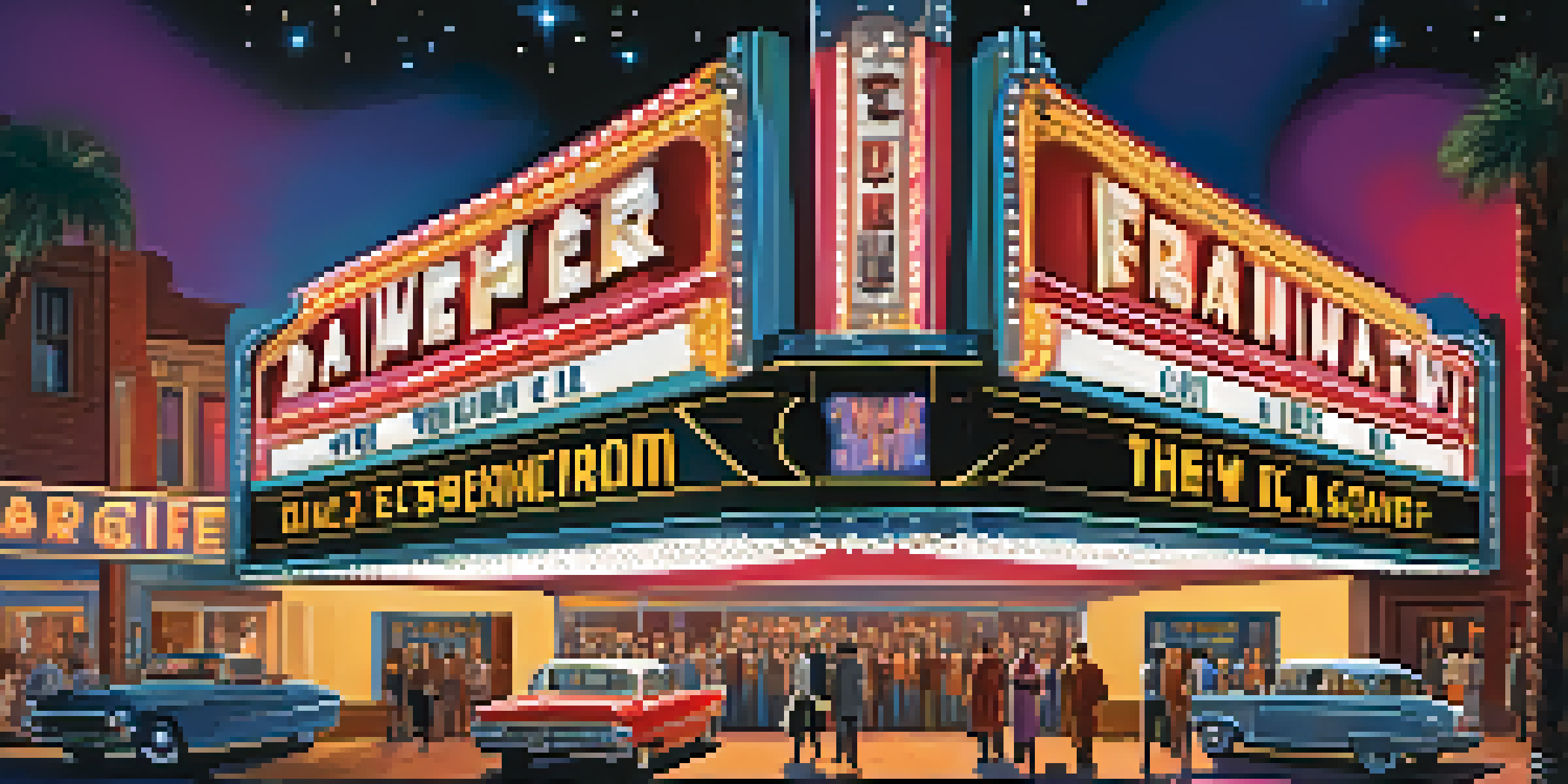Defining Cult Classics: What Makes a Film Cultworthy?

Understanding Cult Classics: A Brief Overview
Cult classics are films that, despite not achieving mainstream success upon release, develop a dedicated and passionate following over time. These movies often resonate with audiences for their unique storytelling, unconventional characters, or quirky humor. Think of films like 'The Rocky Horror Picture Show' or 'Donnie Darko'—they didn’t dominate the box office, but they sure found a home in the hearts of fans.
Cult movies are those that are not just films but experiences that create a community around them.
What sets these films apart is their ability to connect with viewers on a personal level, often sparking community among fans. It's not uncommon for these films to inspire fan events, midnight screenings, or even participate in cosplay culture. This vibrant community aspect is a significant part of what makes a film cultworthy.
In essence, cult classics transform from mere movies into cultural phenomena, creating a bond between the film and its audience that transcends typical viewing experiences.
Iconic Characters: The Heart of Cult Classics
One of the defining features of cult classics is their unforgettable characters. These characters often display eccentric traits, complex motivations, or unique styles that make them memorable. For instance, who can forget the flamboyant Frank N. Furter from 'The Rocky Horror Picture Show'? His over-the-top persona has become synonymous with the film itself.

These iconic characters often embody themes of rebellion or nonconformity, appealing to audiences who identify with feeling like outsiders. Through their quirks and flaws, they resonate deeply, creating a sense of connection that transcends the screen. This emotional investment is crucial in cultivating a loyal fanbase.
Cult Classics Build Dedicated Communities
These films foster passionate fanbases that engage in shared experiences, events, and discussions.
In many cases, fans embrace these characters, quoting their lines, dressing up as them, or even creating fan art. This engagement solidifies their status as cult figures, further enhancing the film's cultworthy reputation.
Unique Storytelling: Breaking Conventional Norms
Cult classics often feature unconventional narratives or experimental storytelling techniques that challenge traditional filmmaking norms. These films may have non-linear plots, unexpected twists, or surreal elements that keep viewers guessing. Movies like 'Eraserhead' or 'The Big Lebowski' are perfect examples where the storytelling defies conventional expectations.
Films are the most powerful agents of social change, and cult classics often challenge the status quo.
This distinctive approach can be polarizing—some viewers may love the innovation, while others may find it perplexing. However, it's precisely this divergence from mainstream storytelling that intrigues dedicated fans. They appreciate the creative risks taken, making the film an experience rather than just entertainment.
The inventive storytelling not only captivates viewers but often encourages discussions and interpretations, leading to a deeper appreciation. This dialogue among fans can further solidify a film's cult status, as it becomes a shared journey of exploration and discovery.
Cinematic Aesthetics: Visuals and Soundtracks
The visual style and soundtracks of cult classics play a vital role in their enduring appeal. A distinctive aesthetic—whether it's the gritty look of 'Blade Runner' or the vibrant colors of 'Pink Flamingos'—can create a lasting impression on viewers. These visuals often evoke strong emotions and contribute to the film's overall atmosphere.
Additionally, soundtracks can elevate a film's status, with iconic songs becoming synonymous with the story. For instance, the use of David Bowie’s music in 'The Hunger' enhances its haunting mood, creating a powerful connection with the audience. Fans often associate specific songs or scores with their viewing experiences, adding another layer of nostalgia.
Iconic Characters Drive Fan Engagement
Memorable and eccentric characters resonate with audiences, leading to quotes, cosplay, and fan art.
Together, the cinematic aesthetics and soundtracks contribute significantly to a film's cult status, creating a sensory experience that resonates long after the credits roll. This multi-dimensional appeal is what keeps fans coming back for more.
Themes of Rebellion and Counterculture
Cult classics frequently explore themes of rebellion, nonconformity, and counterculture, making them particularly appealing to audiences seeking an alternative to mainstream narratives. Films like 'Fight Club' or 'A Clockwork Orange' challenge societal norms and provoke thought, sparking conversations about identity, consumerism, and morality.
These themes resonate with viewers who feel alienated or marginalized by conventional society. By showcasing characters who defy expectations or reject societal norms, cult classics create a sense of camaraderie among fans. They find solace in these stories that echo their own desires for freedom and self-expression.
As these themes are revisited and discussed, they grow in relevance, often reflecting contemporary societal issues. This ongoing dialogue keeps the film alive in cultural discussions, ensuring its place as a cult classic.
The Power of Nostalgia: A Cult Classic's Legacy
Nostalgia plays a significant role in the enduring allure of cult classics. Many fans grew up watching these films, and their fond memories create a strong emotional attachment. Whether it’s the quirky humor of 'The Princess Bride' or the thrilling adventure of 'The Goonies', these films transport viewers back to a time when they first discovered them.
This nostalgic connection often leads fans to revisit these films repeatedly, sharing them with new generations. It’s not uncommon to find parents introducing their children to the movies they loved, creating a shared experience that bridges generations. This cycle of discovery helps solidify the film’s place in popular culture.
Nostalgia Fuels Cult Classic Legacy
Emotional connections to these films often lead fans to revisit and share them across generations.
Moreover, nostalgia can lead to resurgence in popularity, as films once considered cult hits find new life through reboots, remakes, or anniversary screenings. This cycle not only reinforces their cult status but also ensures their legacy continues for years to come.
Community and Fandom: Building a Cult Following
The community surrounding cult classics is one of the most vibrant aspects of their legacy. Fans often come together to celebrate their shared love for these films, attending midnight screenings, costume parties, or fan conventions. This sense of belonging fosters connections that go beyond the film itself, creating a unique culture around it.
Social media has amplified this sense of community, allowing fans to connect, share their passion, and create content related to their favorite films. Online forums and fan pages serve as platforms to discuss theories, share fan art, or celebrate anniversaries, keeping the enthusiasm alive. This digital age has made it easier than ever for fans to unite and share their love.

Ultimately, the community aspect reinforces the film's cult status, transforming a simple viewing experience into a collective celebration. This bond among fans is what truly elevates a film to cult classic status, making it a cherished part of their lives.